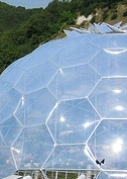To The California Wall
The Pacific fog is finally clearing the tops of the pines, firs and cedars, and the sun is breaking through. A chill westerly from Asia puckers the flesh on your thighs. It’s been three days since you slept indoors – this part of rural Oregon is  sparsely populated. You probably stink, but there’s no one around to smell it.
sparsely populated. You probably stink, but there’s no one around to smell it.
You’ve been walking since first light and the blisters on your feet have split already, but you’ve almost reached the top of the hill and if you keep going, you might actually see your destination.
You allow your mind to go blank, lifting one foot, then the other. Trudge. Trudge. Ignore the squelch of blood and pus. Feel the sun on your face. Into the vacuum of your thoughts comes the memory of Old Man Button’s voice, from one of his endless history lectures: “We always try to reduce the world to simplicity. Think of those old films where the people of the future wore shiny silver suits. As if the whole world could ever be reduced to homogeneity. A time-traveler from the twen-cen to one part of our world would think, ‘Wow! All these people and their clever devices!’ If they visited another part, they might think the locals were savages.” He sighs. “But given that one function of history is to over-simplify the past so we can understand it, think this of your parent’s generation; as the oil began to run out, humanity was at its technological apex. Think how things might be different had they managed to eke out five more years’ progress before we had to ration what oil was left. Think how it would be if we could spend our time advancing our civilization instead of – as we so often must – merely keeping things working. To a large extent we haven’t stopped inventing, just stopped making new things, especially those that rely on petrochemicals.”
Finally, the brow of the hill is in sight. You see a rusting green sign that says “Siskiyou Mountain Summit” and beneath it, “Elev. 4310 ft.”
The answer to his rhetorical question is on the other side of the summit, a mile to south – the California Wall. Rumor has it that it’s impassable, but there are other rumors, that there are gaps in the wall.
You have to take the chance. North of Jefferson it’s over four hundred miles to Seattle, and the tales of gold-paved streets in San Francisco and Los Angeles make it no contest. You were always headed for California the minute your mom’s new friend Vern put a meaty hand on your leg. It just took a few years for it to become clear.
Trudge. Step. Trudge. Step.
Finally, there it is. The ground starts to slope downwards. It’s a mile to the state line.
There’s the Wall, looming out of the fog.
It has to be at least a half a kilometer high, concave, a beige concrete line scarring the entire width of the valley ahead of you, running from the Pacific around California’s state line, implacable in its purpose.
You make out what looks like a township at its base. Hitching your bag strap higher on your shoulder, you start walking with renewed purpose and the faintest of hopes. Maybe you can work your way to an upgrade, become a cyborg – if they exist – serving the Upload Nation as an interface with the world of the flesh.
Your hopes fade as you approach, slowly, your speed decreasing with every weary step. The township is simply a ragged band of canvas tents leaning against the base of the wall, most of them with the fabric rotting away.
You sit down on the tarmac, and give way to despair.
